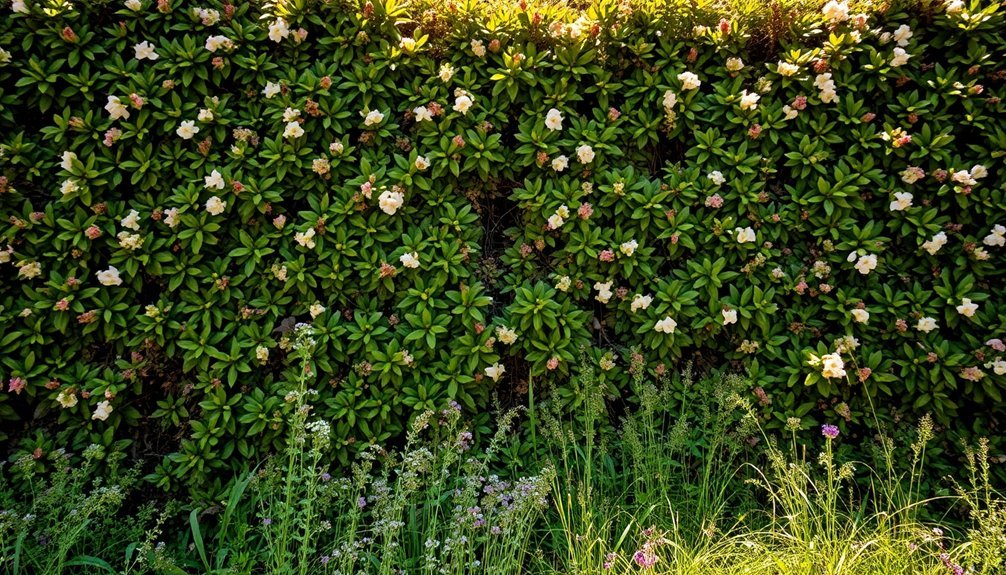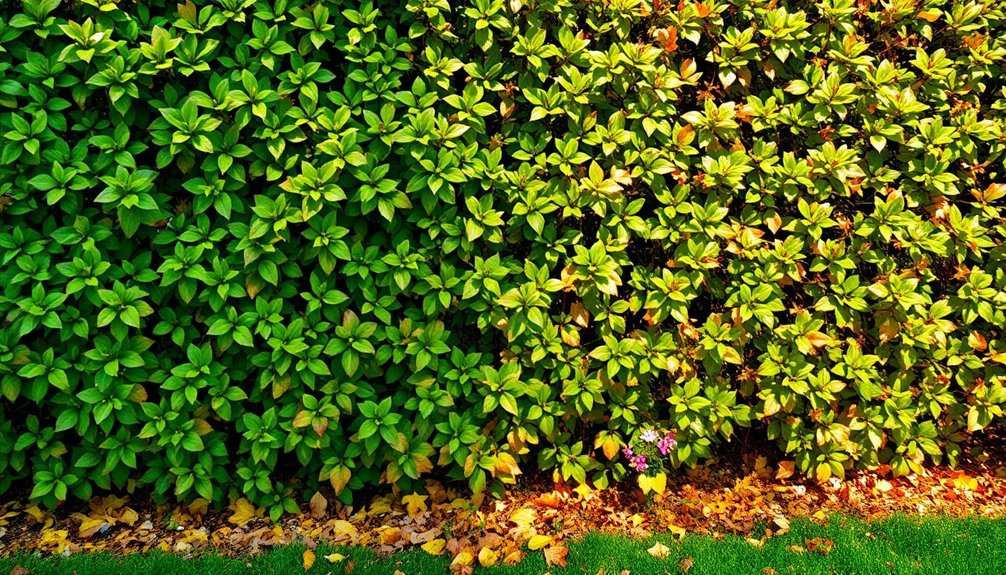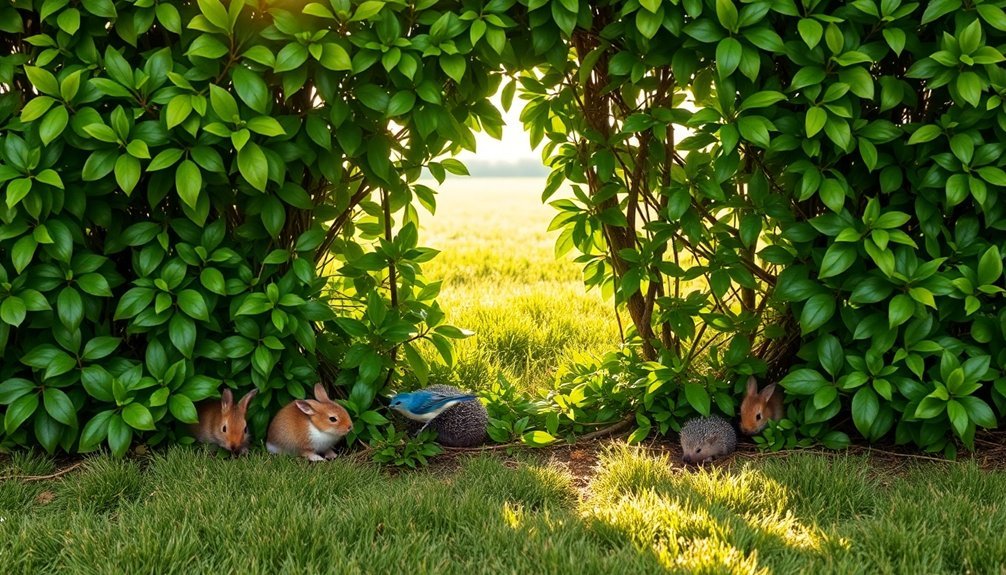Hedges make perfect wildlife sanctuaries because they provide multilayered habitats that support hundreds of species year-round. You'll find these living boundaries offer food, shelter, and safe movement corridors for birds, mammals, and beneficial insects. Their diverse structure—from ground cover to shrubs and canopy—creates microhabitats that native wildlife depends on. With proper native species selection and maintenance, your hedge can become a thriving ecosystem that transforms even the smallest garden into a biodiversity hotspot.
Native Species Selection for Maximum Biodiversity

When establishing hedges as wildlife sanctuaries, selecting the right native species forms the foundation for creating thriving ecological havens. Choose plants that have naturally evolved in your region, as they'll require less maintenance while offering maximum support to local wildlife.
Consider your site's specific conditions—assess light availability, soil moisture, and nutrient levels before making selections. Native species with diverse flowering times will support pollinators throughout the seasons, while those producing berries provide essential food sources for birds and mammals. Incorporate plants with deep root systems that prevent soil erosion and naturally filter water runoff.
Every native hedge plant plays its ecological role—the right selections transform boundaries into vibrant wildlife corridors.
Avoid cultivars of native plants when possible, as they often lack the genetic diversity and ecological synchronization that straight species offer. Instead, seek plants propagated from local ecotypes, which are better adapted to your specific climate and wildlife populations.
This approach guarantees your hedge contributes meaningfully to local biodiversity conservation.
Structure and Layering Techniques for Optimal Wildlife Shelter
The physical architecture of your hedge determines its wildlife value just as much as the plant species you've selected. Creating a hedge with distinct layers—herbaceous ground cover, diverse shrubs, and taller canopy trees—maximizes its habitat potential.
Aim for height and width; taller, wider hedges offer superior protection for nesting birds and support more diverse wildlife populations. Each layer serves a specific ecological purpose, with native shrubs in the middle layer particularly valuable for invertebrates and birds.
Consider traditional hedge laying to rejuvenate aging hedges. This technique promotes dense growth at the base, eliminates gaps, and increases structural complexity. When done properly, hedge laying encourages fresh growth which significantly improves the hedge's density and wildlife habitat value. Stakes and binders provide necessary stability while creating varied microhabitats.
For maximum ecological benefit, connect your hedge to existing wildlife corridors, enabling species like dormice, bats, and butterflies to safely travel across landscapes.
Seasonal Considerations in Hedge Establishment

Successful hedge establishment requires careful timing with the seasonal calendar for ideal wildlife benefits and plant health.
You'll find November through March is the best planting window, avoiding heavy frost periods while allowing roots to establish before summer droughts arrive. When planning, consider species that bloom at different times to provide a continuous food supply for pollinators and birds throughout the year. Initial harsh trimming promotes denser, bushier growth that creates better wildlife habitat.
- Plant bare root stock in late autumn when dormant plants can focus energy on root development instead of leaf growth.
- Create staggered double rows with 8 whips per meter to form dense wildlife refuges that offer protection from predators and harsh weather.
- Select climate-appropriate species that will thrive in your specific soil conditions while providing maximum ecological benefits across seasons.
Maintenance Practices That Preserve Habitat Value
Properly maintaining your hedge sanctuary requires balancing traditional gardening practices with wildlife conservation principles.
Adopt a relaxed cutting regime, trimming only once every three years rather than annually. When you do prune, cut about 10cm higher and wider than previous cuts to enhance berry production for birds.
You'll need to monitor for pests and diseases regularly, but opt for organic controls like insecticidal soap rather than harsh chemicals that harm beneficial insects.
Apply mulch around the base to retain moisture and suppress weeds without disturbing wildlife habitats.
Schedule any major renovation work outside nesting seasons to avoid disrupting breeding birds.
Deep watering once or twice weekly supports plant health without waterlogging soil.
Remember that properly maintained hedges create essential wildlife corridors, connecting fragmented habitats and allowing species to move safely through the landscape.
Creating Wildlife Corridors Through Strategic Hedge Placement

When strategically placed across landscapes, hedges function as essential wildlife highways, connecting isolated habitat patches that would otherwise remain fragmented.
You'll maximize biodiversity benefits by linking existing woodlands, ponds, and meadows with thoughtfully positioned hedgerows.
For effective wildlife corridors, consider:
- Creating gaps in fences or installing 'hedgehog highways' (13cm x 13cm holes) to maintain continuous pathways between gardens and natural areas
- Planting mixed native species like blackthorn and hawthorn that provide food, shelter and diverse microhabitats throughout the seasons
- Establishing hedge networks that bypass dangerous roads, reducing wildlife-vehicle collisions and creating safe passage for dormice, hedgehogs and other vulnerable species
Remember that connected landscapes allow wildlife to access resources, find mates, and adapt to environmental changes—making your hedge placement strategy vital for conservation success. The A-shaped hedge structure provides the greatest corridor width for wildlife movement while maximizing habitat value.
Frequently Asked Questions
How Do Hedgerows Affect Nearby Property Values?
Hedgerows can increase your property value by up to 20% through enhanced curb appeal, privacy, and security. They'll make your property more marketable, helping it sell faster while also providing environmental benefits.
Can Hedgerows Help Reduce Traffic Noise and Air Pollution?
Yes, you'll benefit from hedgerows as they reduce traffic noise by creating sound barriers and cut air pollution by up to 50% by capturing particulates at exhaust level, unlike trees in urban settings.
What Funding Options Exist for Hedgerow Planting Projects?
You'll find diverse funding for hedgerow projects through government programs like USDA NRCS, non-profits such as Tilth Alliance, local conservation districts, and corporate partnerships with organizations like the Woodland Trust.
How Do Hedgerows Compare to Fences for Privacy and Security?
Hedgerows offer better privacy and security than fences. You'll enjoy noise reduction, natural beauty, and deterrence from prickly varieties, while requiring less maintenance than fences that need regular painting or replacement.
Do Hedgerows Attract Unwanted Pests to Residential Gardens?
While you might worry about pests, properly maintained hedgerows actually reduce pest problems by attracting beneficial predators. They're self-regulating ecosystems where natural enemies control potential pests, reducing your need for pesticides in your garden.
In Summary
You'll create a living haven by choosing native plants, layering your hedge, and planning for all seasons. As you maintain with wildlife in mind and connect hedges across landscapes, you're building essential corridors for countless creatures. Your humble hedge isn't just a boundary—it's a vibrant ecosystem that's providing food, shelter, and safe passage for local wildlife right in your own backyard.





Leave a Reply